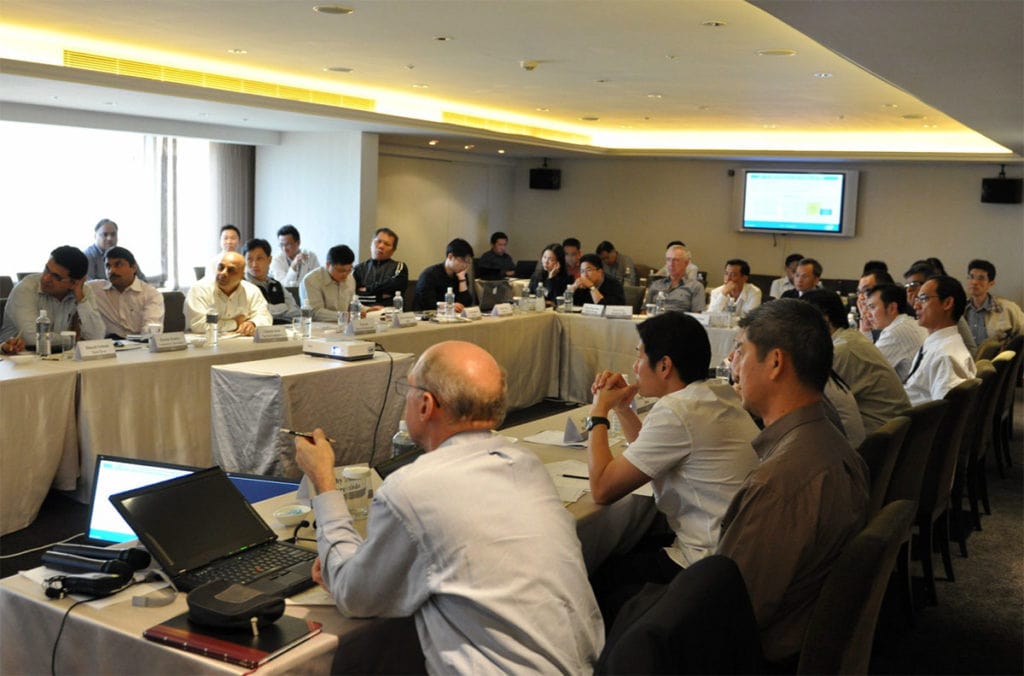How Lateral Career Mobility Unlocks Dormant Potential – Intel Case Study
Imagine being stuck in a never-ending game of musical chairs. The music plays, and you circle the chairs, but when it stops, everyone is eyeing the exact seat you want.
Not fun, right? That’s how the job market within large corporations sometimes feels—significantly when vertical promotions slow down.
Enter Intel, a giant in the tech industry, innovation, and employee growth.
Around 2010, they faced a slowdown in the fast-paced promotions they were known for. Instead of watching their talent get stuck in a loop, they introduced a game-changer through lateral career mobility engagements to transform dormant talent into superstars.
Key Takeaways (TLDR)
- Lateral career mobility initiatives to keep talent engaged when vertical promotions are limited.
- Lateral opportunities provide unique challenges, skill building, and professional networking.
- The Intel Board of Advisors (BOA) became a major success under this initiative.
- Lateral career mobility can provide employees with diverse growth opportunities.
- Data indicates the need for diverse growth pathways.
The Why and What: Special Projects and Team Leadership at Intel
Here’s the deal: Promotions can be as rare as a blue moon if you’re at a large corporation like Intel. To counter this, Intel introduced the concept of “Special Projects and Team Leading,” offering employees a different kind of growth.
These are different from your everyday, run-of-the-mill projects. They are opportunities to step out of their comfort zone, learn new skills, and network like they’re the ultimate business mixer.
Meet Sophia Pollerana, Intel’s Strategic Account Executive turned project leader extraordinaire.
Comfortable in her role managing gaming accounts, Sophia wasn’t seeking promotions. But when Intel launched its “moonlighting” Special Projects and Team Leadership initiative, she was selected to lead the Intel Board of Advisors (BOA).
Think of it as the “Justice League” of the computing world, where top execs and CEOs come together to shape the future of technology.
With retirement on the horizon, Sophia was hesitant and told them, “I’ll help you get it up and running and commit to a year. If it’s not my vibe, a year later, we’ll need to sit and talk about who will take over.”
Intel’s management saw tremendous potential in Sophia and knew that they could trust no one else at the time to handle and develop it with the same care and dedication as she would.
The investment paid off. Sophia excelled in creating the BOA, turning it into a success. Her visibility within the company skyrocketed, and she expanded her professional network significantly, opting to continue leading the BOA until her retirement.
Over the next nine years, while she was at the helm, the program became an even bigger success, so much so that it would replicated across all regions throughout the globe.

After Sofia retired in 2018, the Intel Board of Advisors project lead position became a highly sought-after position that drew in talent from various positions all over Intel.
All hoped to earn the prestige of working on a project that allowed them to increase visibility among Intel’s top executives and granted them access to exclusive networking opportunities like no other.
Having been a part of these events myself for the last decade and seeing it replicated among both AMD and NVIDIA has created an invaluable forum for industry executives like myself to have a roundtable twice a year where we can put aside our competitive nature and work together to solve more pressing global industry issues.
Like these special projects, lateral mobility initiatives can unleash hidden potential and carve out new paths for employees while enriching the vertical and horizontal movement development in a company’s ecosystem. Intel built new ones rather than having employees waiting to climb the ladder.
Types of Lateral Career Mobility Initiatives
In the dynamic landscape of today’s workplace, climbing the corporate ladder isn’t the only way to flex those professional muscles. So, what is career mobility? Think of the lateral movement in career mobility as the gym equipment that targets different skill sets, providing a well-rounded career workout for your employees.
Special Teams and Projects are the weightlifting stations, building their collaborative and leadership capabilities.
Job Shadowing is like that guided class with a seasoned instructor, helping them learn the ins and outs of various roles.
Lastly, Mentorship Programs function as personal fitness coaches, offering tailored advice and strategies for long-term career health.
These three avenues ensure they’re moving, upskilling, and evolving professionally.
Special Teams and Projects: A Closer Look at the Intel Playbook
Similar to how football teams have special units for kicking and defense, these projects can be anything from research to product launches. It’s like a backstage pass to what happens behind the scenes of big, successful companies.
Remember the joy you felt as a kid when you got your hands on a LEGO set? Each piece, seemingly trivial, contributed to creating something magnificent.
That’s precisely how special teams and projects operate within a company like Intel. Each team member brings a unique skill set to the table, and when combined, they create something extraordinary.
Why Special Teams?
These cross-functional teams are composed of people from different departments with unique skills. They assemble for a limited time to tackle a project and then disband once the mission is accomplished.
Intel’s special teams were pivotal in developing the talent strategy they needed for the Intel Board of Advisors (BOA). It was a task that required strategic thinking, leadership skills, and a dash of creativity.
How to Execute: The Intel Recipe
- Identify Objectives: Determine what you want the special team to achieve. Is it product development, market research, or a new branding initiative? You can only send them on a road trip if you give them a destination, right?
- Select the Right Team: Cherry-pick professionals with the skills needed for the project. It’s like assembling a dream team for a weekend basketball game. You want the best shooters, defenders, and playmakers.
- Allocate Resources: These projects often require special budgets, technology, or other resources. Ensuring your team has all the tools they need is like ensuring a painter has all their colors—they can’t create a masterpiece without them.
- Set a Timeline: Special projects should have a clear start and end date. No one wants to be stuck in a never-ending meeting; the same goes for projects. Keep it crisp and concise.
- Measure Results: Once the project concludes, evaluate its success. Did you meet your objectives? What can be improved for next time? This is your post-game analysis, where you review what plays led to your win or loss.
According to research by McKinsey & Company, teams that follow these kinds of structured approaches to projects are more passionate, more resilient, and more likely to outperform their goals.
The Bigger Picture
By employing special teams for unique projects, Intel revitalized its internal culture and created a sense of purpose among employees trapped in their roles.
It’s similar to how having a hobby outside work can rejuvenate their mind; these special projects rejuvenate the professional spirit.
Key Takeaways for Special Projects
Special teams and projects at Intel are the career development equivalent of a golden ticket in a chocolate bar. They open up a world of opportunities, help them network with people they wouldn’t usually interact with, and expose them to skills and responsibilities that aren’t part of their daily grind.
Introducing these special initiatives could be the next game-winning move if your company wants to re-energize its workforce.
Job Shadowing: The Understated Hero of Employee Development
Remember when you were a kid, and you’d follow someone you admired to learn how they do what they do?
That’s job shadowing but for adults. Employees get to swap departments and gain insights into roles they might never have considered.
It’s like a ‘try before you buy‘ deal that lets them dip their toes into another role without fully committing.
The Skinny on Job Shadowing
Job shadowing is a professional development tactic where you follow someone in another role, observing their day-to-day activities.
It’s a real-time, on-the-job training that provides an unfiltered look into another position’s duties, challenges, and satisfactions.
The Nitty-Gritty: How to Get Started
- Identify Objectives: Just like with special projects, they must know why they’re undertaking this endeavor. Are they looking to switch departments, gain new skills, or satisfy curiosity?
- Find a Shadowee: Ensure there are procedures for someone to approach someone in a role that interests them—or manage it through the HR department. It’s like asking someone to be their gym buddy; make sure they’re okay sharing their routine with them.
- Set the Parameters: Decide how long this shadowing will last. Will it be for a few hours, days, or weeks? Unlike a Netflix binge, they can’t consume everything in one sitting. It would be best if they had time to absorb what they’re learning.
- Engage, Don’t Interfere: During the shadowing process, they’re there to observe, not to disrupt their work. It’s not a ‘hands-on’ experience but more of a ‘hands-off, eyes-on situation.
- Reflect and Apply: After the experience, consider what they’ve learned. How can they apply these new insights to their current or future role? If job shadowing was like sampling a dish, this is the part where they decide whether to go for a full plate.
According to a study by the Harvard Business Review, top companies, including Amazon, JP Morgan Chase, and PwC 2023, have invested millions and even billions into “upskilling” their employees. They believe the pandemic has accelerated the need to “retool their employees quickly” to adapt to new priorities they expect to emerge soon.
More Than Just a Learning Experience
Besides gaining insights into another role or perspective, making a lateral career move in a job through shadowing fosters cross-departmental understanding.
They learn the challenges and constraints that their colleagues in other departments face.
This can improve inter-departmental relations—suddenly, the marketing team understands why the engineering team can’t make a feature change at the drop of a hat, and vice versa.
Key Take Aways For Job Shadowing
Job shadowing is like a backstage pass into another job role. It’s a priceless learning experience that can be both enlightening and enriching, sharpening their career toolkit with new skills and perspectives.
Suppose a company aims to improve and enhance the quality of its organizational culture. In that case, job shadowing is an underused yet highly effective tool for development.
Mentorship Programs: The Trusted Roadmap for Career Navigation
This is like having a business Yoda. Experienced colleagues guide them through the labyrinth that is their career, helping them avoid the pitfalls and showing them the shortcuts.
According to data in a report from Pew Research, “60% of U.S. employees who quit their jobs in the past year cited a lack of career advancement opportunities.”
Imagine them driving on a long, winding road that is their career path. Sure, they can figure it out themselves. Still, it would be great to have a GPS telling them the quickest way to reach their destination, where to avoid construction, and where the nearest coffee shops are.
A mentor is like that trusty GPS, offering the best shortcuts and invaluable insights that only come with experience.
What’s the Big Deal About Mentorship?
If you think back to your favorite teacher or coach, they likely shared knowledge and wisdom, right?
A mentor in a workplace functions similarly—they’re the go-to resource for career advice, professional development, and sometimes, the hard truths they need to hear.
It’s the difference between learning how to fish and understanding where all the best fishing spots are.
According to a survey by the Harvard Business Review, 76% of professionals believe having a mentor is essential, yet only 37% have one.
This gap demonstrates a widespread understanding of the value of mentorship but a lack of actual participation—sort of like how everyone says they should exercise more but don’t always hit the gym.
Helping them Find Their Career GPS
- Know The Coordinates: They must understand their career goals before finding a mentor. They will only get much out of a GPS if they know their destination.
- Scout for a Mentor: Provide opportunities for them to look for experienced individuals within your organization. For example, the department can post mentorship opportunities on a company message board. Then, the mentor can vet them just as he would any other applicant.
- Set Guidelines: If they agree, setting expectations is next. How often will they meet? What are some objectives? Mentorship isn’t a one-size-fits-all t-shirt; it should be tailored to suit their goals and not affect their regular job duties.
- Engage in Honest Conversations: Encourage them to discuss their fears, challenges, and opportunities with the mentor. Remember, a GPS can only reroute them if it knows they’ve hit a traffic jam.
According to the American Society for Training and Development, 71% of employers at Fortune 500 companies offer professional mentorship programs, leading to higher employee engagement, job satisfaction, and retention.
The Ripple Effect of Mentorship
Besides individual and lateral growth in the career, mentorship programs have a more beneficial ripple effect across the organization. They foster a culture of continuous learning, improve skills, and create a supportive work environment.
Mentors themselves often report feeling a sense of accomplishment and renewed inspiration, enriching their career journey.
Key Take Aways For Mentorship Programs
A mentorship program is like having a secret sauce in the career development kitchen. It adds flavor to their experience, offering depth and richness that otherwise would take too much work. So, suppose they’re still navigating their career development path without a GPS. In that case, it may be time to find a mentor and enjoy the smoother, more enlightened ride.
Critical Considerations for Effective Lateral Career Mobility
If you’re thinking of introducing a lateral job move or vertical movement in a company with job mobility projects, here are some golden nuggets to chew on:
- Clear Objectives: Know what you’re aiming to achieve. Intel aimed to unlock the dormant potential in Sophia and create a unique but seasonal program to dedicate an entire position or department to.
- Time Commitment: Special projects are not a fling; they require commitment. Make sure you’re ready to commit to the project.
- Skill Matching: Ensure that you find the right people with the skills that align with the project. It’s like choosing the proper workout for the muscle group you want them to focus on.
Wrapping Up
Intel’s approach to lateral career mobility through Special Projects and Team Leading didn’t just move chairs around; it added more chairs to the game.
Whether tackling a new project, shadowing a colleague, or finding a mentor, lateral career mobility is the unsung hero of career development. He is a lateral promotion in some ways.
And hey, if companies as giant as Intel can pivot and add this to their playbook, the potential for smaller businesses to adapt and grow in the same way is not just possible—it’s a no-brainer.
Frequently Asked Questions
What are lateral mobility examples?
Lateral mobility in the workplace encompasses various opportunities for employees to grow without necessarily moving up the hierarchy. Examples include Special Teams and Projects, where employees can lead or participate in cross-divisional initiatives; Job Shadowing, which allows staff to observe and learn from roles in other departments; and Mentorship Programs, where seasoned professionals provide guidance and support to junior team members. These initiatives equip employees with a broader skill set and more diversified experience.
Why is lateral mobility important?
Lateral and upward mobility in a job is essential for employee engagement and organizational health. Lateral moves at work are akin to cross-training in fitness—by diversifying roles and experiences, employees are more likely to remain engaged, adaptable, and committed. For organizations, it fosters a culture of continuous learning, encourages collaboration across departments, and helps retain top talent by providing alternative pathways for growth when vertical or upward mobility in a company is limited or not desired.
What is upward mobility?
Upward mobility refers to the more traditional trajectory of career development and growth, where employees move up the organizational ladder, taking on roles with increased responsibilities and, often, higher pay. Think of it as a straightforward climb up a mountain. Each step ascends workers to greater heights, offering improved vistas but requiring more skill and effort. While it’s a tangible measure of career progress, upward career mobility isn’t the only pathway to professional development, especially in today’s multifaceted work environments.







